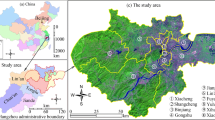Abstract
The unavoidable birth defects for current simulation method make the final simulation results cannot truly reflect the evolution rules of urban land layout. In this way, a multi-agent simulation method based on FPGA for urban land layout is proposed in this paper. The evolution rule of urban eco-land is explored by combination of cellular automata, dynamic reconfiguration and multi-agent methods. Relying on platform of MATLAB software and dynamic reconfiguration of FPGA logic resources, a regional ANN-CA-Agent model for evolution and prediction model of urban land layout is established. MATLAB, FPGA, and ArcGIS are interoperable by programming, and foreground is displayed by the repast tool. The input layer contains 18 data layers, and the output layer contains 6 data layers. A multi-agent model is established for studying the evolution of urban land layout structures. Finally, in order to make calculation results of the model more in line with actual situation and reflect uncertainty of urban system, random factors are added. Example analysis results show that simulation accuracy of the proposed land layout structure reaches 92.4%, which is a high simulation accuracy. Moreover, conclusion shows that speed of urban expansion in the study area from 2007 to 2029 has gradually slowed down, and urban land-use pattern has changed from epitaxial expansion to intensive land-use.






Similar content being viewed by others
References
Beck SM, Mchale MR, Hess GR (2016) Beyond impervious: urban land-cover pattern variation and implications for watershed management. Environ Manag 58(1):15–30
Xie L, Zhang H, Liu M, Wang C (2016) Identification of changes in urban land cover type using fully polarimetric SAR data. Remote Sensing Letters 7(7):691–700
Li M, Gong F, Fu J, She M, Zhu H (2011) The sustainable approach to the green space layout in highdensity urban environment: a case study of Macau Peninsula. Procedia Engineering 21(3):922–928
Xia W, Wei X (2016) Sar image simulation and verification for urban structures. Int J Electron 103(2):247–260
Shen QX, LI CG, Liu Q (2017) Urban spatial structure by service facilities distribution :a case in main districts of Changchun. Econ Geogr 37(3):129–135
Lu ZW, Xu LH, Wu YQ (2016) Spatial distribution of construction land of central urban area based on suitability evaluation——a case study of Hangzhou. Resources and Environment in the Yangtze Basin 25(6):904–912
Zeng Y, Huang W, Jin W et al (2016) Multi-agent based simulation of optimal urban land use allocation in the middle reaches of the Yangtze River, China. XLI-B8:1089–1092
Xia C, Wang H, Zhang A, Zhang W (2017) A high-performance cellular automata model for urban simulation based on vectorization and parallel computing technology. Int J Geogr Inf Sci 32(2):1–26
Guan Q, Shi X, Huang M, Lai C (2016) A hybrid parallel cellular automata model for urban growth simulation over gpu/cpu heterogeneous architectures. Int J Geogr Inf Sci 30(3):494–514
Xue B, Sun C, Zhou F, Bai X, Xiong X (2016) Semi-automated infrared simulation on real urban scenes based on multi-view images. Opt Express 24(11):11345–11375
Zimmermann N (2016) From plans to land change: how strategic spatial planning contributes to the development of urban regions (concur). J Cell Physiol 228(1):225–234
Hu T, Yang J, Li X, Gong P (2016) Mapping urban land use by using landsat images and open social data. Remote Sens 8(2):151
Mariwah S, Osei KN, Amenyo-Xa MS (2017) Urban land use/land cover changes in the Tema metropolitan area (1990–2010). Geojournal 82(2):247–258
Wang W (2017) Study on simulation of urban color landscape design and optimization. Computer Simulation 34(6):241–244
Kuang W, Yang T, Yan F (2018) Regional urban land-cover characteristics and ecological regulation during the construction of xiong'an new district, Hebei province, China. Acta Geograph Sin 28(1):109–123
Liu S, Liu G, Zhou H (2019) A robust parallel object tracking method for illumination variations. Mobile Networks and Applications, accepted. https://doi.org/10.1007/s11036-018-1134-8
Crociani L, Lämmel G, Vizzari G (2016) Multi-scale simulation for crowd management: a case study in an urban scenario[C]. In: International conference on autonomous agents and multiagent systems. Springer, Cham, pp 147–162
Crociani L, Lämmel G, Vizzari G (2016) Simulation-aided crowd management: a multi-scale model for an urban case study[C]. In: International workshop on agent based modelling of urban systems. Springer International Publishing, pp 151–171
Liu S, Bai W, Liu G et al (2018) Parallel fractal compression method for big video data. Complexity 2018:2016976
Liu S, Pan Z, Cheng X (2017) A novel fast fractal image compression method based on distance clustering in high dimensional sphere surface. Fractals 25(4):1740004
Liu S, Cheng X, W F et al (2014) Numeric characteristics of generalized M-set with its asymptote. Appl Math Comput 243:767–774
Zeng Y, Huang W, Jin W et al (2016) Multi-agent based simulation of optimal urban land use allocation in the middle reaches of the Yangtze River, China. In: ISPRS - international archives of the photogrammetry, remote sensing and spatial information sciences, pp 1089–1092
Acknowledgments
This research is supported by following grants: Natural Science Foundation of Inner Mongolia [No. 2018MS6010]; Foundation Science Research Start-up Fund of Inner Mongolia Agriculture University. [JC2016005]; Scientific Research Foundation for Doctors of Inner Mongolia Agriculture University. [NDYB2016-11]; Baoji University of Arts and Sciences Key Research (Grant No.: ZK2017010).
Author information
Authors and Affiliations
Corresponding author
Additional information
Publisher’s Note
Springer Nature remains neutral with regard to jurisdictional claims in published maps and institutional affiliations.
Rights and permissions
About this article
Cite this article
Zhou, X., Fu, W. A Multi-Agent Simulation Method of Urban Land Layout Structure Based on FPGA. Mobile Netw Appl 25, 1572–1581 (2020). https://doi.org/10.1007/s11036-019-01361-0
Published:
Issue Date:
DOI: https://doi.org/10.1007/s11036-019-01361-0




